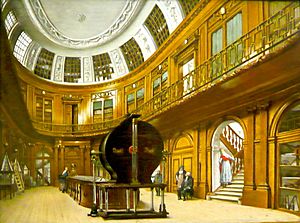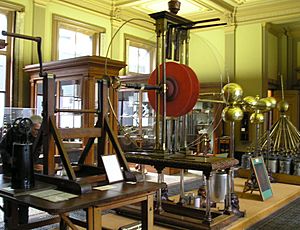Martin van Marum facts for kids

Martin van Marum (born March 20, 1750, in Delft – died December 26, 1837, in Haarlem) was a Dutch doctor, inventor, scientist, and teacher. He studied medicine and philosophy in Groningen. Van Marum brought modern chemistry to the Netherlands, following the ideas of Lavoisier. He also created many scientific tools for everyday use.
He became famous for his public demonstrations. His most well-known instrument was the Large electricity machine. He used it to show static electricity and perform chemistry experiments. He did this while working as a curator for the Teylers Museum.
Van Marum also studied Boyle's law, which describes how gases behave. He found that ammonium gas did not follow Boyle's law perfectly when pressure increased. He was the first person to turn ammonium gas into a liquid, which happened at 7 atmospheres of pressure.
Contents
Biography
Early Life and Work
Martin van Marum was born in Delft. In 1776, he moved to Haarlem. He believed people in Haarlem were more interested in science than anywhere else in the Netherlands. When he arrived, he started working as a doctor. However, he spent most of his time giving lectures on physics. He also built instruments to show how physics theories worked.
Van Marum made a big impression on Haarlem society. He became a member of the Dutch Society of Science in the same year he moved. The next year, he was made director and curator of their collection of interesting objects. At first, he didn't get paid. But he found a way to earn a salary by taking over duties from the previous caretaker.
Leading Two Museums
In 1779, van Marum was asked to look after the "Second Society." This was a group created by Pieter Teyler van der Hulst (1702–1778) in his will. This led to the creation of the Teylers Museum. Teyler's money was split into three groups: one for religion, one for science, and one for art. These were called the first, second, and third societies.
In 1794, van Marum also became the secretary and director of the Dutch Society of Science. Under his leadership, both the Teylers Museum and the Dutch Society of Science became very famous in Europe. People traveling through Europe often mentioned visiting both museums.
Van Marum was also a member of many other important scientific groups. These included the Provinciaal Utrechtsch Genootschap van Kunsten en Wetenschappen and the Académie des Sciences. In 1808, he was asked to help create the Royal Netherlands Academy of Arts and Sciences. He became a member of this new institution that same year.
Combining Collections
Under van Marum's guidance, the two societies slowly started to work together. His name is closely linked to the Electriseermachine. This was the largest electricity demonstration machine of its time. It used Leiden jars and was a huge hit with visitors at the young Teylers Museum. This impressive machine is still on display today. A smaller version can be seen at the Museum Boerhaave in Leiden. Van Marum's scientific studies, especially with electricity, were many and varied.
The Teylers Museum continued to be a place for scientific research. It still has many important scientific models from that period. These include items about electricity, weather stations, and early industrial machines. The Teylers collection focused on scientific theories. The Dutch Society of Science collection focused more on practical science.
Teylers Museum and Art
In 1784, the Teylers Museum opened its new 'Oval Room'. An artist named Vincent Jansz van der Vinne was hired to look after the art collection. However, he left the next year due to disagreements with van Marum about art and museum opening hours.
The Teylers Museum then hired another local artist, Wybrand Hendricks. He painted the famous Oval Room and many other scenes of Haarlem. Hendricks was responsible for buying many Old Master prints for the Teylers collection. He bought a large collection of prints and drawings in Rome in 1790. This collection had once belonged to Christina of Sweden.
Van Marum was very busy giving public demonstrations of electricity in the Oval Room. He also spent a lot of time building the Teyler library's collection of scientific books. He focused on three types of books:
- Greek and Latin authors.
- Books on natural history, including travelogues (travel stories).
- Scientific magazines, including all publications from the Royal Society of London.
Van Marum organized special "gentleman evenings" in Pieter Teyler's library. This allowed people to view the collection. This tradition still continues today.
Legacy
Today, the public can visit the museum rooms during the day. However, Pieter Teyler's private rooms in the "Fundatiehuis" are only open one day a year. Because of its strong scientific history, many famous physicists moved to Haarlem to work at Teyler's. These include Nobel prize winners Pieter Zeeman and Hendrik Lorentz.
The Teylers Museum opened a new wing in 1996. This wing displays parts of van Marum's library collection in rotation. For example, they show the works of John James Audubon alongside stuffed birds from Naturalis.
See also
 In Spanish: Martinus van Marum para niños
In Spanish: Martinus van Marum para niños




